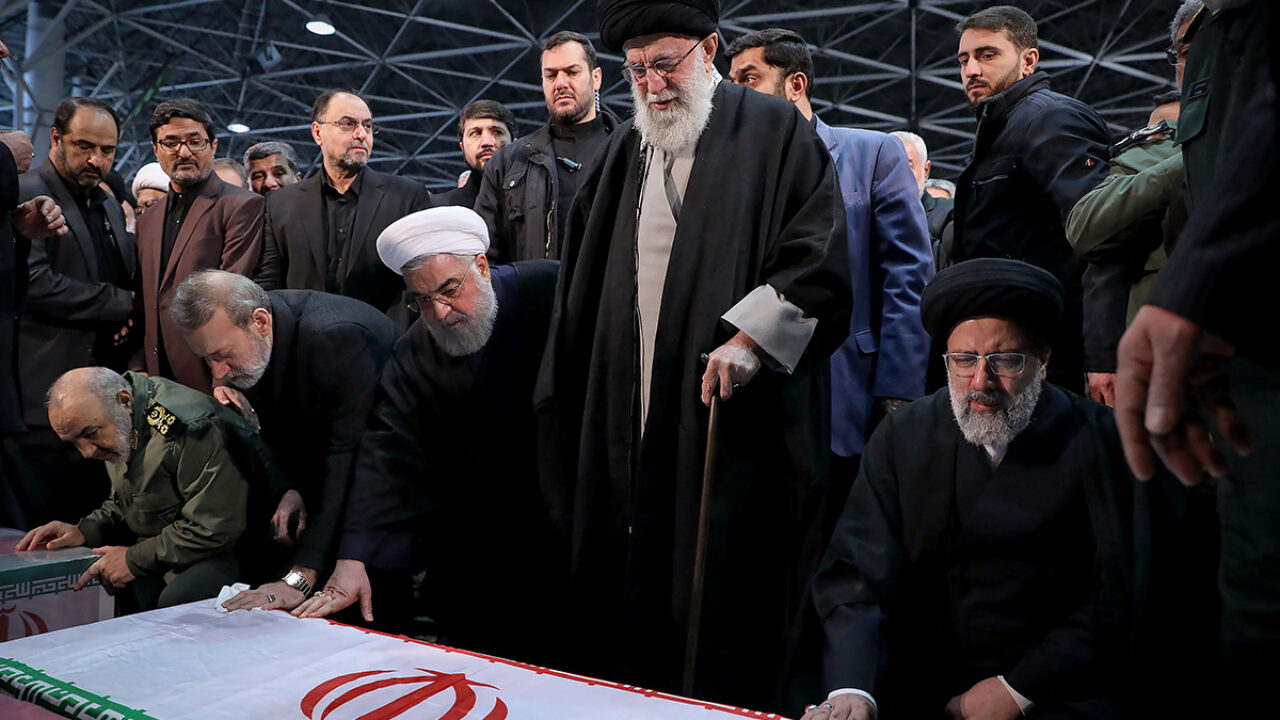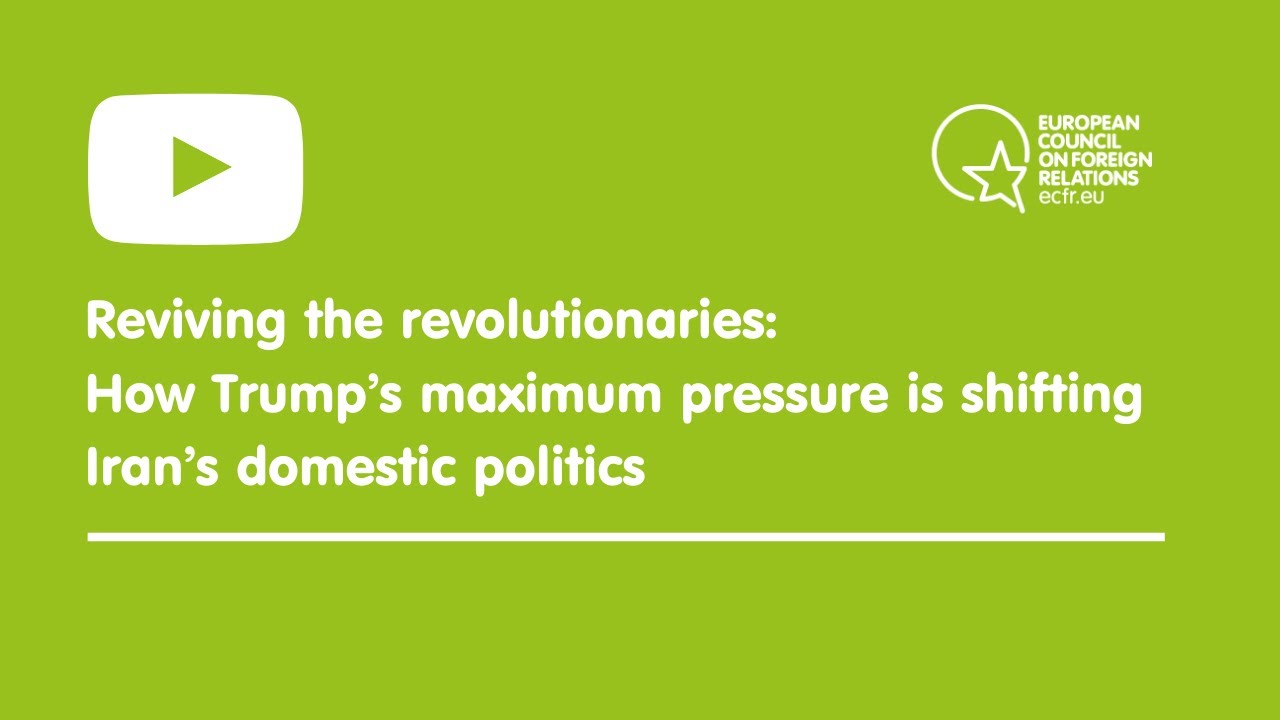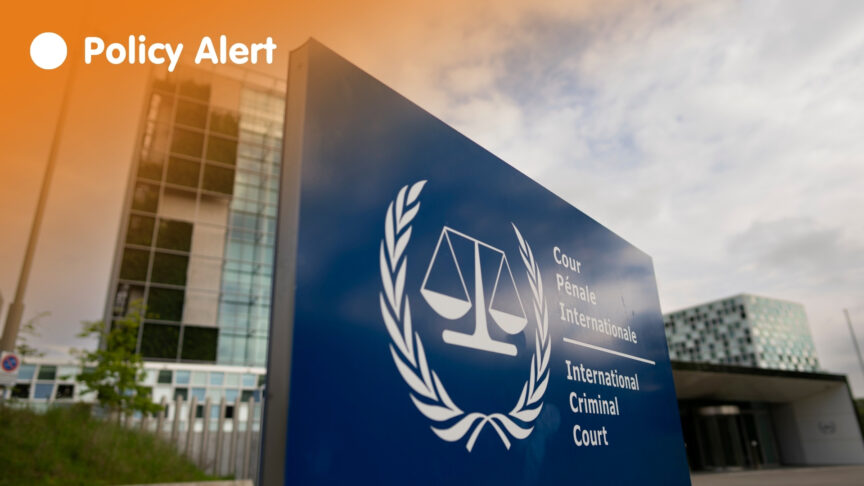Reviving the revolutionaries: How Trump’s maximum pressure is shifting Iran’s domestic politics
Summary
- Europeans wish to persuade Iran to compromise on strategic issues – but, unless they understand the dynamics of domestic Iranian politics, they will not get far.
- Three main power blocs compete to influence Iran’s supreme leader, including the ‘modernisers’, who were instrumental in building the case internally for the nuclear deal. The US ‘maximum pressure’ campaign has placed them on the back foot.
- Improving the economy remains the most pressing issue in Iran. Without a Western economic offer, the other two power blocs – the conservative ‘Principlists’ and IRGC-linked ‘securocrats’ – will continue their recent ascendancy and press for a confrontational ‘maximum resistance’ response.
- Immediately after the US presidential election, Europeans should embark on shuttle diplomacy with Washington and Tehran to agree an interim deal on the nuclear issue. This could also strengthen modernisers ahead of Iran’s own presidential race in 2021.
Introduction
Iran’s actions regularly capture global attention, but there remains too little understanding of the country’s internal priorities and politics. This includes Western governments seeking to negotiate directly with Iran. The words and actions of would-be negotiators – especially those in the United States and Europe – resonate loudly in Iran. After the long-haul diplomacy that led to the nuclear deal in 2015, the Trump administration’s ‘maximum pressure’ campaign against Iran has pushed the mainstream of Iranian politics away from support for engaging with the West. Meanwhile, arguments put forward by political forces inside Iran that present themselves as protectors of the 1979 revolution have gained traction. If European capitals wish to advance their Iran policy, especially in light of the upcoming US presidential election, they should seek deeper insights into what influences decision-makers in Tehran.
Iran has a complex political ecosystem comprising shifting and competing factions. These factions’ political ups and downs directly affect the decisions that emerge from the web of state organs overseen by Supreme Leader Ali Khamenei. He, in turn, is constantly alive to these influencers, who represent the country’s republican and theocratic features, and who vie to propose different ways to strengthen the country’s economic vision and security. The results of this interplay can surprise even the country’s own leadership.
The biggest challenge facing the country’s leaders is the economy, which has long been hampered by chronic mismanagement, corruption, and sanctions. Lately, a string of crises – ranging from nationwide protests, military tensions with the US, plummeting oil prices, and the arrival of covid-19 – has compounded these problems. It is impossible to separate the internal debate about how to run Iran’s economy from how to manage relations with the US: since 2013, relatively moderate forces have held the presidency under Hassan Rouhani, who has sought to make a success of diplomacy with the West to improve the economy by securing the lifting of sanctions. The US withdrawal from the nuclear deal in 2018 put these forces on the back foot. Camps pressing for a more aggressive approach towards the West and for greater self-sufficiency within the domestic economy have since grown in influence. They are aligned to the already-powerful Islamic Revolutionary Guard Corps (IRGC), which is now in a new ascendancy and has the ear of the supreme leader.
The United States’ maximum pressure campaign, combined with a more confrontational approach from Iran, has culminated in military clashes between the sides. It is in European interest to actively disrupt this escalatory cycle, which has already led to direct military attacks in Iraq and instability in the critical trading route through the Strait of Hormuz. Should the maximum pressure campaign continue into the next US administration, even greater risks will likely land on Europe’s doorstep, including expanded Iranian nuclear and missile programmes. A triumph for maximalism in this form will most likely lead to defeat for moderates in Iran in the country’s next presidential election, likely to take place in May or June 2021.
This paper maps how power operates inside Iran, describing how the various factions that shape decisions approach the country’s difficulties and attempt to influence the supreme leader. It draws on the author’s discussions with Iranian officials and analysts closely engaged with Iran’s internal politics, together with extensive open-source research into how the narratives issued by Iran’s various power centres have evolved during the US maximum pressure campaign. The paper considers what shifting dynamics inside Iran mean for whether and how Europe can ensure diplomacy restrains Iran’s nuclear programme, limits the development and transfer of its missiles, and influences Iran’s regional behaviour. Acquiring a deeper understanding of the wishes, priorities, and methods of Iran’s domestic power blocs will allow Europe to tailor its diplomacy more effectively.
As this paper will show, it is economic matters and the nuclear file that represent the best way for Europe to persuade Iran and the US to engage in meaningful negotiations with each other. Following the US presidential election in November, European actors should – regardless of who wins – immediately begin a high-level political push for Iran to freeze and roll back its nuclear activities. This is most likely achievable if European actors successfully press Washington to first provide a reasonable economic package to Iran.
If Europe gets this right, it could create a diplomatic opening between the US election and the Iranian presidential election. Such an opening could even influence who enters the Iranian electoral race, and its outcome. Iran’s moderate power centres currently have a weak hand internally, but they are not completely in retreat. European governments should do all they can to find diplomatic options with such moderate forces in the remainder of Rouhani’s term, and to lay the foundations of a political process that can continue under his successor.
How power operates in Iran
Three fundamental concepts are important in understanding politics in the Islamic Republic of Iran: dualism, pragmatism, and the nezam.
To take dualism first: as the country’s full name suggests, the constitution is established on the dual structure of Islamic and democratic values that replaced the monarchy system in 1979. Unelected institutions and individuals directly appointed by the supreme leader, in accordance with the constitution, are often closely linked to more hardline elements that prioritise Islamic and revolutionary values. Democratic elements are embodied in elected organs such as the parliament and the presidency. They exist so that that the system can secure some form of popular legitimacy through elections.
However, in recent decades, this dualism has become increasingly lopsided, with more conservative forces seeking to use the Islamic and revolutionary principles to increase their share of power at the expense of democratic practice. The experience of the 1980s is crucial to understanding this evolution. The Iran-Iraq war that decade created the foundations for unelected institutions to tighten their grip on power. This includes the IRGC, which recruited and mobilised front-line fighters. Afterwards, the IRGC and its network of Basij paramilitary forces received many privileges in recognition of their wartime sacrifices. Since then, this network has integrated into Iran’s security, political, and economic institutions. Meanwhile, elected branches of the Iranian system have struggled with an ever-tighter vetting process overseen by largely unelected bodies whose members are handpicked by the supreme leader. Parliamentarians have found themselves sidelined and successive presidents have struggled against arch-conservative camps to influence the supreme leader.

The second fundamental concept within Iranian decision-making is maslahat – pragmatism. Iran’s first supreme leader, Ruhollah Khomeini, introduced this concept. Pragmatism is embodied in the creation of the Expediency Council, charged with resolving disputes between the parliament and the conservative-leaning and unelected Guardian Council. Khomeini applied maslahat in accepting a United Nations ceasefire in 1988 to end the eight years of war with Iraq, a decision he referred to as drinking from the “chalice of poison”. Since then, to advance their interests, Iran’s leaders have recognised that ruling requires, at times, expediency, pragmatism, and modification of revolutionary ideals. On foreign policy issues, these decisions are almost always packaged in face-saving ways to justify concessions Iran has made. Understanding the importance of maslahat as a core concept in Iran’s governance should tell observers that the Iranian decision-making system is not the inflexible machine it is sometimes made out to be. Instead, its DNA contains a go-to concept for responding to events.
Another example is Khamenei’s call for “heroic flexibility” in accepting the Joint Comprehensive Plan of Action (JCPOA) in 2015, which did not lift all sanctions as he had insisted during negotiations over the deal. Khamenei later vowed to “set fire” to the nuclear deal if the US withdrew from it, but the more moderate forces in the Iranian political system convinced him to preserve the agreement even without the US. And, although the supreme leader repeatedly rejects direct talks with the Trump administration, he has allowed the government to test diplomatic efforts.
This includes a proposal led by Emmanuel Macron in 2019, which came close to achieving a political breakthrough between Tehran and Washington. After months of shuttle diplomacy, Iran indicated that it was open to reducing its nuclear activities, going beyond the JCPOA, and engaging in further multilateral talks – including those with the US. In return, Tehran wanted Washington to provide some economic relief, which reportedly involved access to $15 billion in hard currency through letters of credit. In the end, the two sides reached an impasse. The Trump administration was unwilling to take the first step to allow Tehran to secure a face-saving road map.[1] But, as noted in the final section of this paper, this impasse may be surmountable with a reiterated version of the Macron proposal and enough political will from the US and Iran.
Finally, to understand decision-making in Iran, one must recognise that the country’s political system resembles a web of decision-shapers and institutions, referred to as the nezam. This is a system of governance that includes the elected and unelected centres of power, which also embody the steadily shifting array of political factions in Iran. The duality of the system often means that elected and unelected branches within the nezam produce competing and disjointed policies. Over time, the role of Iran’s supreme leader has become paramount in making the final call on behalf of the nezam – maintaining order and consensus, especially in times of crisis.
The range of thinking within the nezam is captured in various institutions. Iran’s Supreme National Security Council (SNSC) is perhaps the most important decision-making body established under the constitution to institutionalise the factional politics that emerged after the revolution. Among others, members of the body include the president, parliament speaker, judiciary chief, military commanders, and key ministers and security chiefs. The SNSC takes critical security decisions, in particular those relating to national sovereignty. Most members of the SNSC are directly or indirectly appointed by the supreme leader and, in practice, he has veto power over the SNSC’s decisions.
The US maximum pressure campaign has had an impact on the SNSC in recent years, leading Khamenei to become more actively involved in the body’s decision-making from the outset. This is especially so during times of emergency, such as on 3 January this year, when Khamenei convened the SNSC a matter of hours after the US assassinated the IRGC’s Quds Force commander, General Qassem Soleimani. This meeting led to the swift appointment of a new Quds Force chief and the decision to launch missile attacks against the Ain Al-Asad base in Iraq, which hosts US troops. The SNSC also made the decision, announced in May 2019, that Iran would gradually reduce compliance with the JCPOA.
A second and newer institution to watch closely is the Supreme Council of Economic Coordination (SCEC), which was formed in 2018 under the guise of the supreme leader. This is a fast-track institution for decisions on strategic economic problems that have arisen in light of the US maximum pressure campaign. The heads of the judiciary, the legislature, and the executive together form the consultative body that delivers the SCEC’s final recommendations to the supreme leader. The SCEC announced in November 2019 the controversial decision to reduce pressure on the government budget by removing long-standing fuel subsidies. Despite its relative novelty, several experts interviewed for this paper agreed that the SCEC could yet prove to be the most critical institution for steering Iran’s economy out of the covid-19 and US sanctions storm.
Power blocs shaping decisions
While the supreme leader is the ultimate decision-maker in Iran, three main groups operate within the nezam framework: the ‘modernisers’; a political faction formally calling itself the ‘Principlists’; and ‘securocrats’. These three blocs all seek to gain the supreme leader’s support for their proposals, and thereby greater power. None of these groups is anti-establishment and they all accept the supreme leader’s role as the final arbiter. This is in contrast with, for example, those who recently participated in nationwide protests, some of them calling for radical changes such as the rejection of the entire political establishment.
The modernisers seek change within the parameters of the Islamic Republic. Relative to other camps, they take a conciliatory approach to domestic and foreign policy while generally supporting diplomacy with the West. This group includes ‘moderate centrists’ who currently control the executive branch under Rouhani’s presidency. Their primary goal is to make economic and technological progress by integrating Iran with the global economy. Key figures among moderate centrists have included pragmatic political operators such as Rouhani and former president Akbar Hashemi Rafsanjani, who died in 2017.
Also belonging to the modernisers is a political group formally called the ‘Reformists’. Their main goal is to advance civil, social, and political rights within Iran. This group is led by former president Mohammad Khatami and is closely associated with the 2009 Green Movement protests, whose leaders remain under house arrest. The Reformists are currently sidelined, with some of their political organisations outlawed or severely weakened. Khatami himself is still an important political voice, and has galvanised support for Rouhani’s presidential campaigns.
However, members of the Reformists are increasingly distancing themselves from the moderate centrists, stating that they regret having tied “the fate of reform movement to Rouhani”. Reformists did poorly in the February 2020 parliamentary election. Their representatives had either been disqualified from standing in the first place, or their candidates failed to attract enough votes from an electorate disappointed by the pace of political and social progress these candidates had pushed for while serving in parliament. One Reformist figure predicts the faction “may well go through a metamorphosis” in the coming years: this camp needs to come up with a new strategy to both regain their popularity among voters, and to preserve their influence within the nezam.[2]
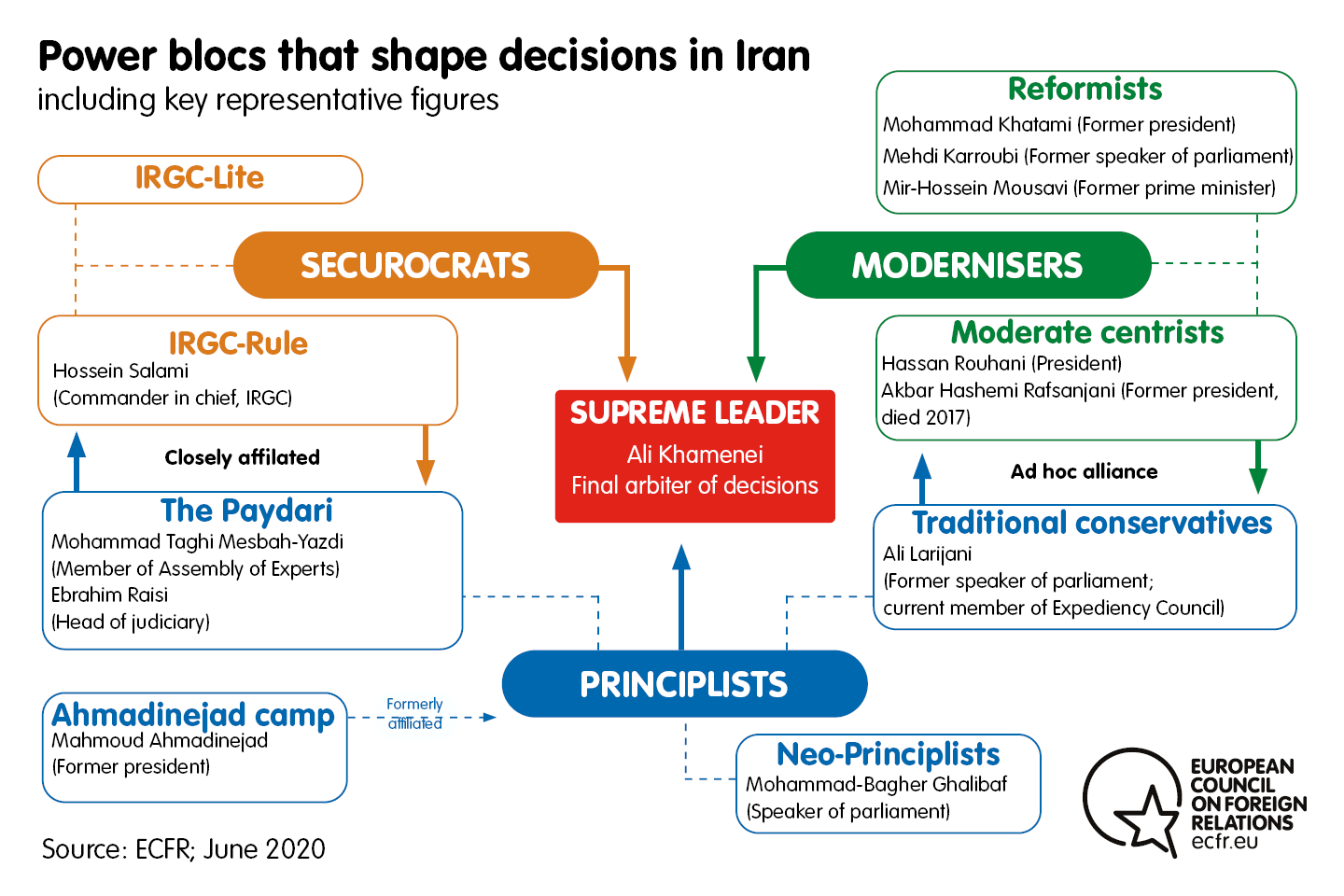
The second major camp comprises the Principlists, a political entity claiming to defend the core foundations of the 1979 revolution – including the fight against imperialism and corruption, as well as the protection of the poor. Figures associated with this group are known for populist messaging and policies that focus on social welfare. As for negotiations with the West, most Principlists maintain that such talks are harmful to Iran and that Europeans are not trustworthy. They are largely absolute devotees of the supreme leader. In return for their loyalty, Khamenei has increased their share of power over the years through appointments to important positions, such as those in the Guardian Council and the judiciary. That said, the Principlist camp includes such a wide range of subgroups that one political analyst describes the faction as a “herd of cats” – which, until the recent parliamentary election, found it difficult to coalesce in a way that would attract voters as the modernisers had in a string of votes since 2013.[3]
‘Traditional conservatives’ form part of the diverse Principlist camp. Key figures in this subgroup include members of the traditional clerical establishment and the recently retired speaker of parliament Ali Larijani, whom the supreme leader appointed in May to act as his adviser and serve as a member of the Expediency Council. Under Larijani’s leadership, traditional conservatives have been willing to join forces with moderate centrists on issues such as support for the JCPOA. On the economic front, they also backed moderate centrists in implementing the Financial Action Task Force (FATF) road map, which entailed a series of financial sector reforms that European governments insist are necessary for Iran to reconnect with international banks. Other Principlists opposed, and successfully blocked, Iran’s full implementation of the FATF road map.
The alliance of traditional conservatives and the moderate centrist Rouhani administration is partly due to the increasing radicalisation of some Principlists (such as the ‘Paydari’ group described below), and the poor track record of former president Mahmoud Ahmadinejad. He brought with him a new corrupt political and economic network, while his administration’s diplomatic failure helped place Iran under extensive UN Security Council sanctions. In his first term in office, Ahmadinejad was affiliated with the Principlists. But, by his second term, he had fallen out of favour with the supreme leader and is no longer formally supported by the Principlists. There is now a recognised following of the ‘Ahmadinejad camp’ that is highly centralised around him personally and his populist social agenda. There are signs that Ahmadinejad will either look to stand in next year’s presidential election or field a candidate close to his camp.
The most powerful subgroup within the Principlists is known as the Paydari (the Front of Islamic Revolution Stability). Members of this subgroup have an ultraconservative and securitised approach towards governance, and they fiercely opposed the nuclear talks with the West. They generally prefer hard military power projection over conciliation with Iran’s enemies and are highly sceptical of diplomatic engagement with Europe. Hardline cleric Mohammad Taghi Mesbah-Yazdi oversees this strict school of thought, and is currently a member of the Assembly of Experts. Prominent figures endorsed by the Paydari camp in past elections include the head of Iran’s judiciary, Ebrahim Raisi, who lost the 2017 election to Rouhani, and Saeed Jalili, who led the nuclear talks under Ahmadinejad and currently represents the supreme leader at the SNCS. The Paydari camp now has a strong presence in parliament and will look to seize the presidency in 2021.
Finally, the ‘Neo-Principlists’ are a relatively new faction established by former mayor of Tehran and former IRGC senior general Mohammad Bagher Ghalibaf after he lost the 2017 presidential election. Ghalibaf argues that the Principlists need an overhaul of the ageing top echelons, who dominate power in this camp. He wants the Principlists to be more inclusive of younger generations. This year Ghalibaf was elected to parliament and has been appointed speaker. However, voices within the Paydari group have been quick to criticise Ghalibaf for supporting the nuclear deal, and media outlets linked to the Principlists have described him as “inclined towards the liberalistic ideology of the other side [the Rouhani camp]”. Indeed, Ghalibaf has openly outlined his support for the nuclear talks, but has attacked Rouhani for the details agreed under the JCPOA. Ghalibaf is increasingly viewed as an opportunist who not only carries weight with parts of the IRGC, but is willing to align with different political camps to increase his chances of standing in and winning next year’s presidential election.[4]
The third camp that holds extensive power in Iran is the securocrats, whose core goals include increasing the IRGC’s control over Iran’s security, economic, and regional affairs. The securocrats have remained strong allies of Khamenei, helping him to contain internal upheaval and external threats. The IRGC is constitutionally mandated to defend Iran’s territorial integrity and the Islamic revolution. Using its influence on security matters, the IRGC has pushed the country to expand its military capabilities through homegrown technology and regional affiliates that deter and attack foreign enemies.
Unlike the modernisers and Principlists, who have formed a distinct political platform and whose leaders stand in elections, the IRGC generally keeps a low profile in the public political sphere. Currently, the Paydari group within the Principlists has close associations with the more hardline elements of the IRGC. As one expert has put it, the securocrats “don’t need a General Sisi [Egypt’s president] as they have enough figures with IRGC serving in the background without uniforms that can safeguard their stake in political battlefield”.[5] Throughout the country, the IRGC has influence over local issues thanks to its broadly based, dedicated Basij units. The IRGC is also engaged with the SNSC and is directly answerable to the supreme leader as commander-in-chief. Given their close partnership with the supreme leader, the securocrats have access to a financial network overseen by Khamenei in addition to their own businesses, both of which help fund the IRGC’s activities.
One analyst studying IRGC networks concluded that, among the securocrats, the “dominant voices prefer IRGC-rule – while the minority prefer IRGC-lite order”, finding that some in the minority group support the modernisers on specific economic issues and the need to avoid war with the US.[6] The dominant trend is led by “those at [the] forefront of fighting in Syria, who view everything, including internal politics, through that lens: politics is a battlefield of the war with US.”[7] However, another senior expert in Iran viewed this matter differently, arguing that the Quds Force, which has been at the forefront of conflicts in the region, “has been obliged to be more pragmatic as they have to work and cut deals with different actors, tribes, and warlords in the region – Sunnis, Shia, and the Kurds”.[8] While there are differences among the securocrats over how to exercise their immense power, the IRGC umbrella organisation headed by Brigadier General Hossein Salami and the IRGC’s Intelligence Organisation drive the hardline elements within the securocrats grouping. They have been emboldened by the US maximum pressure campaign to push Iran towards a more confrontational and securitised form of politics.
People to watch: read the profiles
Shifting power
While all three power blocs can influence the decisions of the nezam through their participation in state institutions such as the SNSC, Khamenei has generally placed specific camps in the lead on different strategic issues. This has traditionally ensured a relative balance of power between the blocs that helps sustain the supreme leader’s authority. Under the Rouhani administration, the modernisers largely oversee economic policy, diplomacy with global and regional powers, and nuclear negotiations. As such, they have been the main counterparts to European governments for almost eight years. The Principlists and the securocrats have long held power over internal security matters and the judiciary (and, under Ahmadinejad, the Iranian nuclear programme). Iran’s military activity in the Middle East and missiles programme are led by the securocrats, primarily the IRGC.
Several factors have caused the modernisers’ influence over these strategic portfolios to weaken in recent years. Firstly, as external US pressure has increased, the supreme leader has sought to homogenise the inner circle of leadership in order to reduce internal infighting in times of crisis and to be better able to deal with the US.[9] The extensive disqualification of candidates affiliated with the modernisers and traditional conservatives prior to the 2020 parliamentary election suggests that Iran’s political system is tightening into a small group of acceptable elites known as the khodis – the insiders. Modernisers are currently attempting to resist this trend, however. For example, marking the Persian new year in March, foreign minister Mohammad Javad Zarif explicitly proposed an effort to break down barriers between the acceptable inner circle and those considered to be outsiders by the political elite, as well as for “mental housekeeping” to create unity in fighting covid-19 and US sanctions.
Secondly, the securocrats and the Paydari among the Principlists are the most fervent supporters of the supreme leader. As such, they have risen to power at the expense of elected institutions. As one expert explains, the IRGC was empowered during the war with Iraq because Khomeini “didn’t trust the American-trained armed entities that survived the revolution – and wanted a parallel back-up army devoted to the cause of the Islamic revolution.”[10] This devotion to the role of the supreme leader has endured since the revolution, while successive elected presidents have experienced major tensions with Khamenei.
Today, the securocrats and the supreme leader are engaged in a partnership in which the IRGC and its nationwide network have created the Islamic Republic’s principal bedrock of support in terms of both voter base and individuals who have joined the IRGC and its Basij networks. As one senior figure deeply engaged with Iranian politics put it, the securocrats and the Principlists carry at least 30 percent of the country who are willing to “sacrifice extensively to preserve” the ruling order.[11] And, as seen in the response to the November protests – which, according to Amnesty International, resulted in at least 304 deaths – this includes the extensive use of force against internal dissent.
Such devotion to, and protection of, the Islamic Republic appears to have become more important to the supreme leader as the US has sought to weaken Iran’s political system and economy. This is reflected in the supreme leader’s unequivocal support for the IRGC. In January, the IRGC’s seemingly accidental downing of a Ukrainian airliner – which left 176 people dead – occurred hours after Iran retaliated against the US assassination of Soleimani by attacking American troops based in Iraq. This caused immense harm to the IRGC’s reputation, not least through what appeared to be an initial attempt to cover up its role. The event exposed rifts between the securocrats and the modernisers, with one senior adviser to Rouhani warning of the grave risks associated with military rule. At that moment, Khamenei could have moved to strike a new balance between the elected and unelected branches of the system. But, in a major speech following the crisis, Khamenei gave the IRGC his full support, hailing them as defenders of the Iranian nation.
Thirdly, the securocrats and hardline Principlists increasingly present themselves to the supreme leader and the wider public as stepping in to fill gaps left by the central government. This includes deterring military strikes on Iranian territory by the US or Israel; thwarting plots by the Islamic State group (ISIS) after a major attack in 2017; launching a military satellite into orbit; and providing disaster relief – most recently in response to covid-19. After several weeks in which Iran’s death rate from the pandemic made it one of the worst-affected countries in the region, the IRGC activated its Basij and financial networks across the country to help the poor, providing food, healthcare, and sanitation. These widely broadcast operations were also an attempt by the IRGC to restore their reputation and bridge the divide with Iran’s middle class following the airliner downing.
Finally, the difficulties the Rouhani administration has faced in recent years in improving the economy have weakened the modernisers more generally. The JCPOA’s economic benefits did not accrue to the Iranian people in the way that had been promised. The state of the economy is the key source of public discontent: as Rouhani nears the end of his term, the country is in a worse economic state than he found it in – despite the grand diplomacy he has undertaken with the West. Some of the president’s political allies are either distancing themselves from him or the JCPOA. One such figure is Ali Shamkhani, who is the secretary of the SNSC. He initially supported the JCPOA, but later argued that “Iran should have never inked the deal”.
For the public and the ruling elite, the JCPOA was a litmus test for whether the modernisers’ pro-diplomacy framework could gradually normalise Iran’s global position. As Iran is again facing international isolation due to US pressure, public opinion has moved against diplomacy and the political pendulum swung in favour of the Principlists during this year’s parliamentary election – in which they took 211 out of 290 seats. The modernisers secured just 19 seats (a sharp fall from 121 in the 2016 election). As one senior Iranian official described it, “the faction that delivers gets the votes”.[12]
As a consequence of the four factors outlined above, the Principlists and the securocrats now control the judiciary, the legislature, the Guardian Council, powerful financial institutions, the state media networks, and most of the security apparatus. A quiet debate is emerging among the modernisers about whether to leave the presidential role uncontested in the 2021 election in order to reduce infighting within the nezam. As one person from the moderniser camp commented, if a figure from within the Principlist camp, who has the backing of the IRGC, became president, they “might get the job done with solving our problems with the US – and, if not, they can carry the political cost with voters”.[13] Others interviewed for this paper warn that Ahmadinejad’s term in office provides a disastrous blueprint for what the securocrats and the Principlists would do, and that the modernisers should try to protect the country from worst-case scenarios by retaining the presidency.
One factor that could significantly alter Iran’s future political trajectory is the succession of the supreme leader, who is 81 years old. There are many unknowns associated with the succession, including whether the role will be taken up by an individual or by a new council. Officials from the Assembly of Experts, a hardline-leaning body charged with appointing the supreme leader, have occasionally commented on the process, revealing that a three-member investigative committee deliberates with Khamenei on a confidential shortlist of candidates. Others note that this list is under review with an updated record of performance for the candidates. Khamenei is likely playing the leading role in the succession and will seek to ensure it is carried out in line with his preferences and in an organised manner. However, it seems improbable that a moderniser will succeed him.
Despite these shifts, the modernisers have not been entirely squeezed out. Although they have been badly burned by the aftermath of the JCPOA, the supreme leader has allowed Rouhani some space. As one senior figure deeply engaged in Iranian politics notes, “in many instances [the supreme leader] has restrained opposition forces from derailing the Rouhani administration”, such as by shielding nuclear negotiators from political attacks from the Principlists who seek to impeach them and by standing with the government’s decision to preserve the JCPOA after the US withdrawal from the deal.[14] For now, the Rouhani administration’s entourage remains in the ‘insider’ group of the nezam. But, if the economy continues to tank on their watch, the modernisers will likely lose influence over strategic decisions and may be removed from high-ranking posts. In these circumstances, their pro-diplomacy vision for Iran stands even less chance of winning support than it does now.
Competing to fix Iran’s problems
Iran’s leaders are currently grappling with three key questions that are directly relevant to European interests. The first of these questions concerns how to rescue the economy and the role the West can and should play in this. The second centres on whether Tehran should engage in any form of diplomacy with Washington, especially after the assassination of Soleimani. The third focuses on whether Iran can protect its interests in the region primarily through diplomatic tools, or whether this requires a more offensive military approach. European governments that wish to persuade Iran to engage in a diplomatic process will need to absorb the lessons of internal debate on these issues.
(i) Rescuing the economy
Today, the main question for Iran’s leaders concerns how to revive the country’s economy. While the economy has long been poorly managed, the last two years under the US maximum pressure campaign have been especially damaging. Iran was already grappling with reimposed US sanctions – which in May 2019 severely restricted its oil exports – before its economy was forced to deal with an unprecedented drop in oil prices and a further hit to its growth prospects following the onset of the covid-19 crisis. Iran’s economy is expected to shrink by around 5.3 percent this year. Waves of protests and unrest make this economic landscape a profound challenge for the entire ruling establishment, particularly given their sense that Washington is trying to foment unrest to bring the system down. Iran now needs to inject money into job-creating sectors in a global environment in which it cannot freely trade or raise capital.
There are two major schools of thoughts about what Iran should do. Modernisers and some traditional conservatives back a ‘modern industrialist’ approach, that favours a global economic outlook in which Iran is unhindered by sanctions and promotes privatisation and neoliberal policies. This model is based on the idea that: “Iran can only reach its potential as a regional economic powerhouse by opening up to foreign investment and technology”, as one senior economist puts it.[15] Another expert describes this as an “economy first” vision for Iran that pursues a “theocratic version of Deng-style China, which was first introduced under Rafsanjani”.[16]
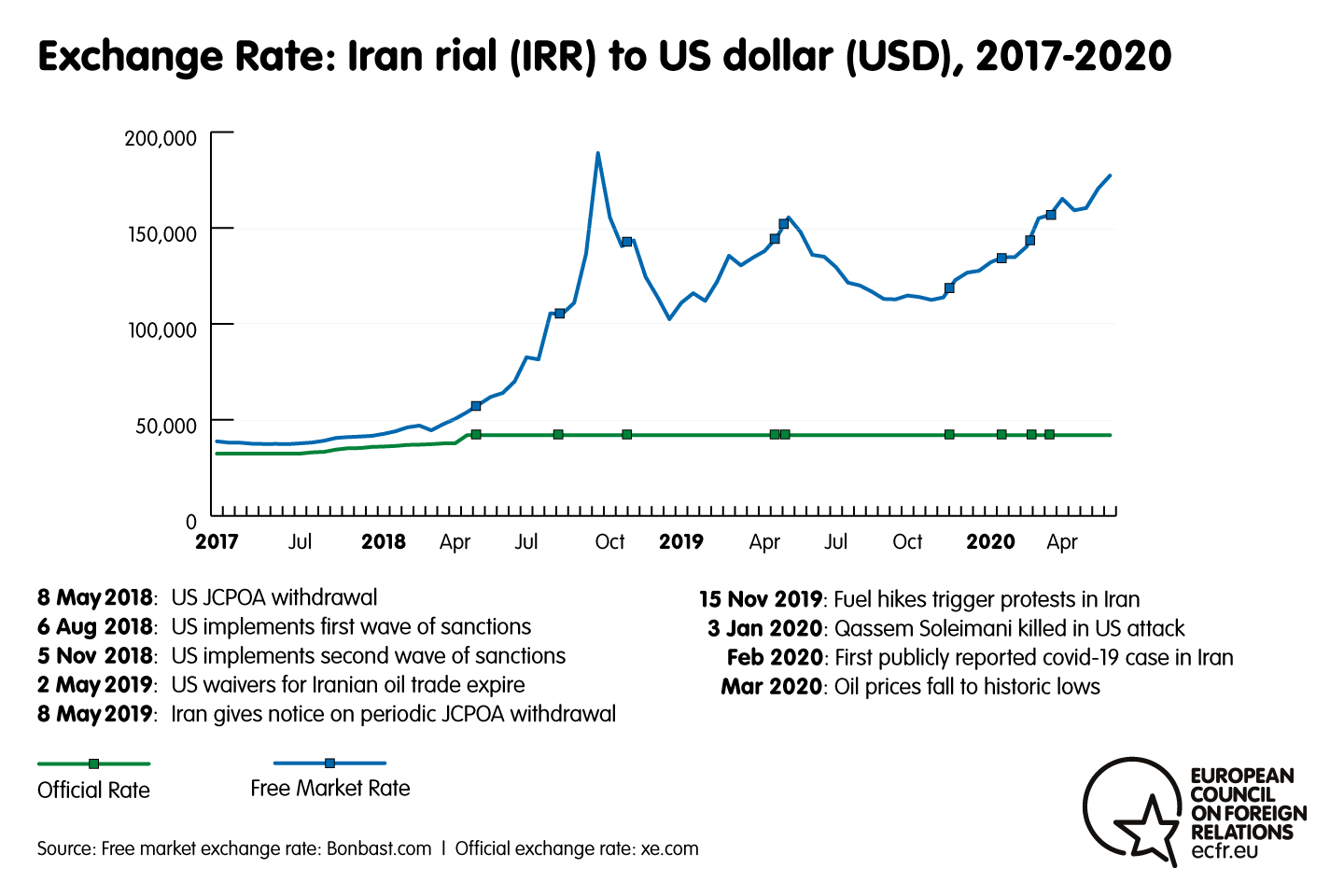
Modernisers blame reimposed US sanctions and the maximum pressure campaign for Iran’s economic downturn. Pointing to falling trade, the Rouhani administration warns that even friendly countries that vow to defy US unilateral sanctions – such as Turkey, China, and Russia – “are afraid of purchasing [Iran’s] oil.” As such, they want to secure sanctions easing through diplomacy. This would enable Iran to receive income from the export of oil and petroleum products, access international financial markets and investment, and draw on its billions of dollars’ worth of reserves frozen in foreign banks.
Meanwhile, the securocrats and most Principlists prefer what is known as the ‘resilient economy’ framework. This focuses on reducing the vulnerability of Iran’s economy to external pressure through improved management, increased domestic production, and techniques designed to bypass sanctions. Its proponents also argue that Iran should look to boost trade with its immediate neighbourhood, and with Russia and China. Such an approach comes with fewer political commitments involving Western actors.
Followers of the resilient economy model brand the Rouhani administration as naive for putting all its eggs in the basket of US sanctions easing via the JCPOA. As a matter of principle, they are less concerned by US sanctions; they would rather circumvent the measures than capitulate to Western pressure. In the eyes of securocrats and Principlists, the JCPOA experience proved that diplomacy will not result in any major economic transformation for Iran, and that concessions only ever benefit the West. On this basis, in January 2020, hardline members of the Expediency Council successfully blocked Iran’s implementation of FATF measures, even though the required legislation was ratified by parliament in 2018. As one expert close to the Principlists outlined, the prevalent position among this camp is that Iran should not open its books to Western institutions, as the FATF road map would have done, when it needs to maintain channels for bypassing US sanctions.[17]

Some supporters of the resilient economy model do not even believe that sanctions have hit Iran’s economy as hard as modernisers claim: a clutch of hardline Principlists have accused Rouhani of exaggerating their impact in order to try to reopen negotiations with the US. Fundamentally, such economic questions are also political. Some supporters of the resilient economy model view it as an expression of a core revolutionary value – to put the poorest first and provide a safety net for those neglected by the previous monarchy system. Keeping Western investment out of Iran is also consistent with revolutionary aims to counter imperialism. The more politically savvy among the Principlists use the resilient economy framework and their dominance in the judiciary to attack modernisers as elitist and corrupt, while presenting themselves as providing the “jihadi management” needed to run the country.
The supreme leader has supported the resilient economy model for many years, a position that he has strengthened in the face of US sanctions. He has also favoured deepened economic ties with eastern economies, which he views as more trustworthy partners and whose leaders similarly vow to resist US sanctions. Khamenei does not deny that sanctions are detrimental, but argues that: “[Iran] cannot keep [itself] waiting on an end to sanctions … strategy should focus on creating immunity against the harms of such sanctions”. According to one economist, Khamenei is “very optimistic that, once you close the country’s doors, the economy will start high domestic production which will create jobs. He is pinning his hopes [on the idea] that ordinary Iranians will show resilience through the difficult days, like in a war front.”[18]
It also appears that Khamenei views the securocrats as best positioned to lead Iran’s resilient economy model through greater involvement of the IRGC. One economist’s view is that, given the failed attempts to lift sanctions, the supreme leader increasingly “connects economic solutions back to the IRGC and has encouraged military forces to enter the production field.”[19] Another economist argues that Khamenei is generally suspicious of modern industrialists, many of whom have links abroad: the “IRGC and Khamenei view themselves as [the owners] of the economy – while others are guests. The IRGC died for the country and didn’t pack up and leave because things got tough”.[20] Benefiting from this, the securocrats have built an extensive economic network that is expected to thrive further in the sanctions environment. Shortly after the advent of the JCPOA, the modernisers led a discreet and partially successful effort to reduce the IRGC’s control in the economy. However, the return of US sanctions and exodus of foreign investors from Iran created new economic opportunities for the IRGC, particularly in the energy and automotive sectors.
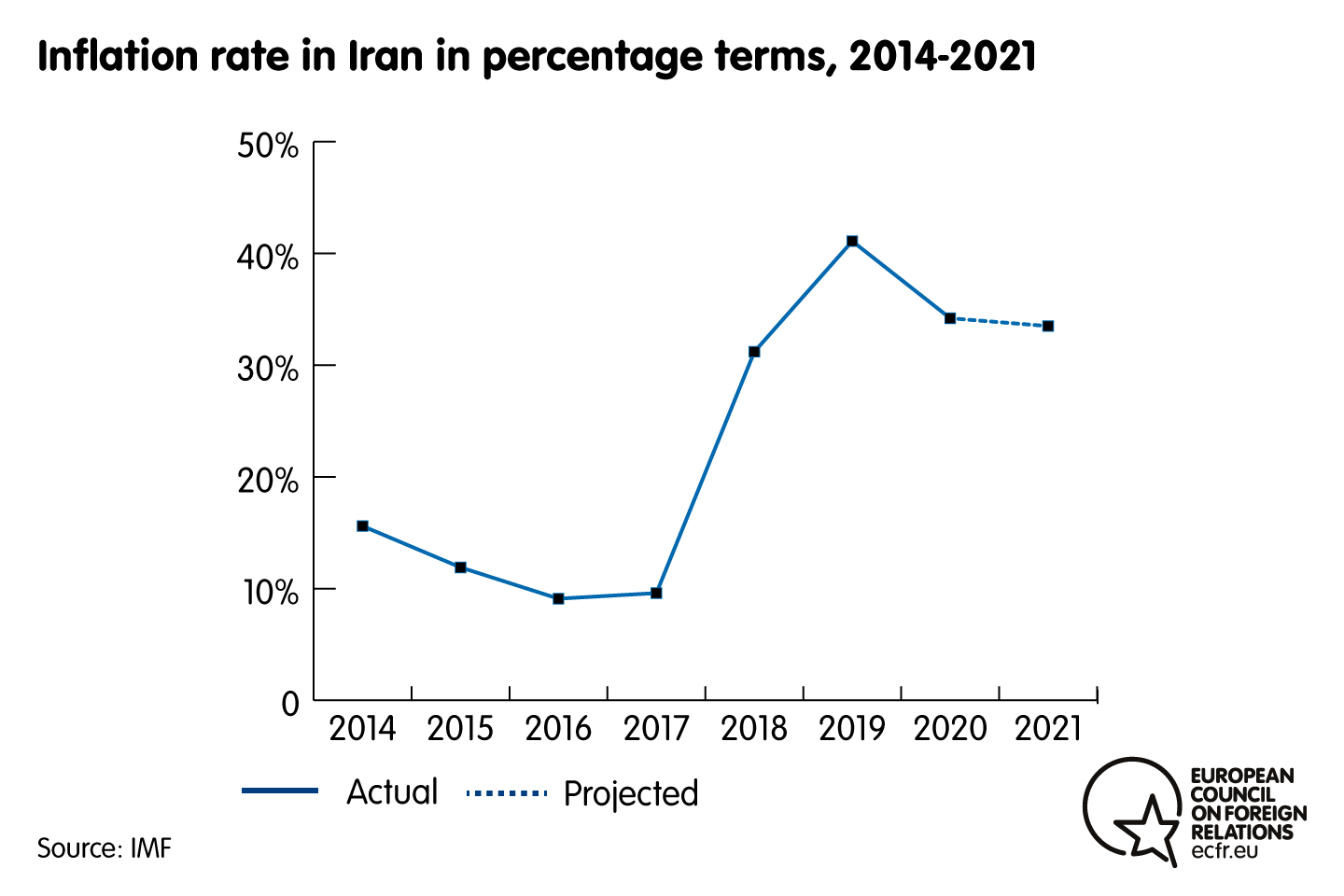
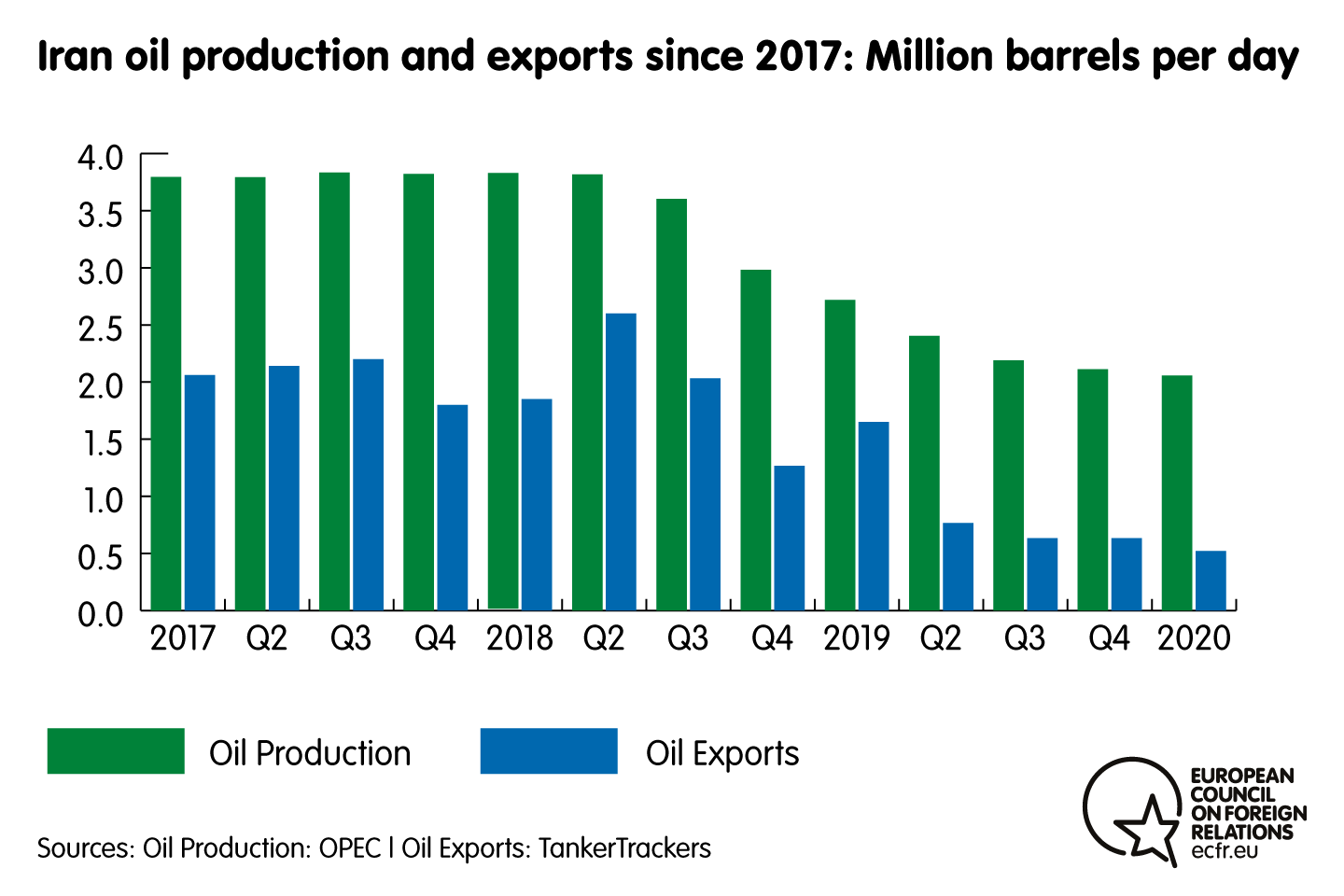
Following the onset of the coronavirus crisis, the battle over the economy has begun to gear up once more. Some Principlists and securocrats are already arguing that the global recession means there is even more need for self-sufficiency. In a speech on covid-19, the supreme leader stressed that the “surge in production” should continue. But the Rouhani government has doubled down on modern industrialist approaches, floating public assets on the stock market, dipping into the country’s sovereign wealth fund, and making a rare request for a loan of $5 billion from the International Monetary Fund (IMF).
Some figures among the modernisers have doubled down on their public calls for Iran to find a diplomatic pathway that reconnects the country to the global economy through sanctions easing. They explicitly link this proposal to the need to manage the covid-19 economic fallout. However, lately, other moderate centrists and traditional conservatives have begun to lend their support to aspects of the resilient economy model. As economic links to the West have shrunk, through a simple process of elimination, Iran’s immediate neighbourhood has become more important than the West for economists in the modernisers’ camp. This is especially so after the Macron initiative failed to shift Donald Trump’s position on sanctions, and when European efforts to provide Iran with economic relief through the Instrument in Support of Trade Exchanges (INSTEX) fell short of expectations in Tehran.
A growing number of people in Iran’s political establishment believe the current and future US administrations will either not budge on sanctions or will seek to extort such large concessions from Iran that diplomacy on economic relief becomes impossible. Overall, Iran’s modernisers see far greater value in sanctions easing and expanded trade relations with Europe, while the more hardline elements within the Principlists and the securocrats see little benefit in re-engagement with the West. Indeed, even with Iran under intense economic pressures this year, both the IMF and the World Bank project in their latest reports on the country that it will experience an economic rebound in 2021. The Principlists and the securocrats are likely to maintain that a sustained resilient economy model can make Iran immune to US sanctions pressure, as the supreme leader has called for. As such, should the Principlists gain the presidency next year, it will be far harder for Western governments to sell sanctions easing as the most attractive option to help Iran’s economy recover.
If Europe wants to persuade Iran to engage in negotiations on security issues, they should recognise that Iranian leaders will primarily look for measures that helps alleviate the economy. Europe’s best shot will be with the modernisers. However, in comparison to the previous round of negotiations in 2013, Iran’s modernisers will now be less satisfied by sanctions waivers that allow countries to purchase its oil. They will be more interested in the easing of US sanctions that block Iran’s access to global financial markets. This would enable Iran to inject substantial funds into job-creating sectors by raising capital on international markets, freely accessing international banking, and importing the technology and equipment needed for boosting local production.
(ii) Diplomacy with the US
Regardless of whether Iran should re-engage with the US in negotiations – on any issue – is a point of real division among Iran’s power centres. The brief political opening under the Obama presidency was possible in part because of the modernisers’ concerted push to secure the easing of sanctions in the face of severe political attacks from other groups. For some securocrats and groups such as the Paydari, it is a fundamental point of belief that US policy is driven by regime change goals; they regard diplomacy as a tool that the US uses to try to weaken Iran. The securocrats also benefit when conflict with external enemies is stoked, as it provides internal legitimacy for bolstering the IRGC’s military strength.
After the US exit from the JCPOA in 2018, modernisers convinced Iran’s leadership to adopt a position of “strategic patience” and remain compliant with the nuclear deal. They were able to do this not least because, at that point, it was unclear how extensively US unilateral sanctions could harm Iran’s economy and how far the US was prepared to go in its maximum pressure campaign. That position lasted for a year, during which time Iran fully complied with the nuclear deal and there was little uptick in military action. However, the modernisers lost ground in May 2019, when the US introduced sanctions designed to create a costly oil embargo on Iran. At this point, the securocrats and the Principlists gained the upper hand over decision-making at the SNSC and successfully pushed for a confrontational response that included expanding the nuclear programme, downing a US drone, and launching missile attacks on US forces based in Iraq.
Most modernisers and traditional conservatives continue to favour a ‘de-escalate and negotiate’ stance towards Washington. They have tried to create space for diplomacy even amid the rising military tensions with the US over the past year. For example, Rouhani and Larijani have repeatedly stated that Iran is open to negotiations if the US lifts its sanctions first and returns to the JCPOA. In practice, the modernisers have signalled their willingness to accept even a temporary easing of US sanctions rather than Trump’s return to the JCPOA – as Macron’s unsuccessful ‘ceasefire’ proposal envisaged. After successive failed attempts to revisit proposals to begin diplomacy with the Trump administration, Iran’s modernisers are not hopeful that progress can be made so long as the US president and his advisers believe Iran is close to capitulation.[21]
Still, America’s zero-sum mentality has forced the modernisers to demonstrate a more united anti-US front in part to preserve their own standing within the nezam, but also because they view such unity as sending a message to Washington that Iran’s leaders are not on the verge of collapse. The United States’ designation of the IRGC as a foreign terrorist organisation in 2019 prompted leading Reformist lawmakers – who had been critical of the IRGC in the past – to attend parliament wearing IRGC uniforms as a symbol of solidarity. Even now, there is growing support among some modernisers for Iran to withdraw from not just the nuclear agreement but also the Non-Proliferation Treaty. Similarly, the US assassination of Soleimani tied the hands of modernisers to oppose a military response – as one Iranian expert linked to this camp describes it, “Trump left us with no choice but to hit back”.[22]
That military escalation led one senior adviser to the modernisers to argue that the time is ripe to pivot towards negotiations with Trump – precisely because Iran had restored its standing by making a credible show of force and signalling its preparedness for war.[23] One senior figure within the moderniser camp shares the worry that further military escalation would only invite increased numbers of US boots on the ground in the Middle East, and would risk dragging Iran into a conventional conflict in which the US had military superiority.[24] In places such as Afghanistan and Iraq, the modernisers have attempted to redirect Tehran’s focus towards influencing local actors to expedite political efforts that could lead to the withdrawal of American troops. This is in line with the supreme leader’s recent remarks that the US will be “expelled” from Syria and Iraq.
The more dominant voices among the securocrats and the Principlists remain adamantly opposed to any negotiation with Washington. IRGC Brigadier General Mohammad Reza Naghdi summed up this viewpoint when he said that “the assassination of General Soleimani was just a result of talks with the US. Whenever we spoke to the enemy in a language other than that of resistance, they dealt us a blow.” The incident provoked intense internal debate. Following Soleimani’s death, this camp lambasted Zarif for a Der Spiegel interview in which he suggested that diplomacy was still an option if the US changed is posture. A military strategist and former IRGC officer claimed that: “the Rouhani government is betraying Soleimani’s blood.”[25] Similarly, in February, Zarif met with US senators, an event that drew extensive criticism from media outlets close to the supreme leader’s office, which described it as “an insult to the Iranian nation.”
However, not all securocrats and Principlists are totally opposed to negotiations with the US. As one expert with close links to the Principlists put it, some in this camp are open to talks with the US “but under their terms and leadership rather than Rouhani’s”.[26] Similarly, the IRGC is known to have accepted transactional dealings with the US in Iraq and Afghanistan under a green light from the supreme leader.[27]
The actual subject of talks also makes a difference to considerations within the nezam. In 2015, when JCPOA negotiations were taking place, Khamenei ruled out dialogue with the US on non-nuclear issues but highlighted that the nuclear talks could be a blueprint for discussing other matters. As one Iranian political analyst describes the situation, “the supreme leader doesn’t cherish confrontation with the US and doesn’t like the situation where Iran is made into an abnormal state. Khamenei knew the nuclear programme was the best way to negotiate with the US rather than regional or domestic issues”, which would be far more complex to resolve.[28] Had the nuclear agreement held, future talks with Iran could have included regional issues. At the time the JCPOA was agreed, Zarif was even at pains to emphasise that the deal was “not a ceiling but a solid foundation” on which to build further diplomacy. But Trump’s U-turn on the JCPOA has vindicated Khamenei’s scepticism of negotiations with Washington domestically and further restricted the modernisers’ room for manoeuvre in attempts to advance talks beyond the nuclear file.
The supreme leader currently maintains a position of ‘neither war nor negotiations’ with the US. Khamenei has approved military strikes against the US but also continues to provide some cover for the modernisers to explore diplomatic options, including a series of detainee exchanges. Analysts interviewed for this paper generally agree that Khamenei does not oppose negotiations with Washington in absolutist terms, but that talks under current circumstances would be tantamount to surrender – if needed, Khamenei is willing to sit the Trump presidency out until Iran can negotiate under better terms.
In contrast to the thinking of the US administration, Tehran may be inclined to negotiate with Washington if it has a relatively strong hand. In an important speech shortly after the death of Soleimani, Khamenei vowed that “getting strong is the only way the Iranian nation has ahead of itself”. The supreme leader is more likely to be open to talks with the US if Iran can negotiate under better terms, which it can gain by at least muddling its way through sanctions, cementing its influence in the region, and obtaining valuable concessions from Washington – which would avoid the impression that it had folded to US pressure. Indeed, Washington and Tehran began their public talks in 2013, after Iran had experienced a deep recession the previous year following the Obama administration’s implementation of sanctions on the country. At the time, Iran had begun to show some signs of economic recovery and the US administration had signalled a willingness to accept Tehran’s desire to enrich uranium on Iranian soil.
The more the Trump administration doubles down on the maximum pressure campaign, the less the modernisers will be willing to stick their necks out again on engagement with Washington. They are only likely to do so if they can guarantee economic returns. Rouhani’s refusal to take the unprecedented step of meeting with Trump – something the US president has repeatedly expressed an interest in – is also likely informed by the experience of North Korea, which has yet to see tangible sanctions relief despite the photo-ops between Trump and the North Korean leader. If the US administration was willing to first take some steps to ease Iran’s economic problems, there would be a much better chance that the supreme leader would permit the Rouhani administration to begin talks with Washington. Such talks would focus only on the nuclear issue for now. In light of Soleimani’s assassination, bilateral negotiations with the US are likely to remain taboo in Tehran. A multilateral setting that includes Russia, China, and Europe would be the most realistic framework in which Iran and the US could conduct a dialogue in the near term.
(iii) Regional security
Iran’s leadership has faced numerous challenges in the Middle East in recent decades, including the war with Saddam Hussein’s Iraq, ongoing threats of US military assaults from bases hosted by its Arab neighbours, and ISIS attacks. Iranians have watched the Middle East become ever more turbulent, while neighbouring Iraq and Afghanistan have struggled to stabilise since the US military interventions there in the early 2000s. To their base, Iran’s leaders present themselves as protectors of the country against strikes by the US and Israel, and of Iran’s largely Shia population from Sunni extremist groups. Iran has an extensive missile programme that its leaders justify as a predominantly defensive measure following the experience in the Iran-Iraq war. Iran has also deployed the so-called ‘forward-defence’ narrative of taking the fight to enemies beyond Iran’s borders to explain the IRGC’s involvement in conflicts such as Syria’s and its support for Hezbollah in Lebanon.
The US maximum pressure campaign and the growing ties between Iran’s regional foes, such as Saudi Arabia and Israel, strengthen the consensus among Iran’s political camps that a united front is needed to reduce external threats. While preferences and tactics differ, all camps have gravitated towards a similar strategic agenda: to reduce the US military presence in the region, contain threats posed by Sunni extremist groups, deter US and Israeli attacks, and prevent a unified anti-Iran front from forming in the Arab world. To pursue these goals, the modernisers lean towards diplomacy and deal-making, while the securocrats and hardline Principlists favour military means.
In recent years, the modernisers have focused on advancing these core objectives primarily through diplomatic outreach with Iraq and members of the Gulf Cooperation Council (GCC). This includes the Kuwaiti-facilitated shuttle diplomacy between Iran and Saudi Arabia in 2016-2017; Zarif’s suggestion last year to establish a new regional security framework based on the UN resolution that ended the Iran-Iraq war; and Rouhani’s 2019 proposal for the “Hormuz Peace Endeavour”. These initiatives have failed to create a meaningful political opening for Iran with Riyadh. This is in part due to US opposition and the impasse with Saudi Arabia’s crown price Mohammad bin Salman – both maintain that there is little point in engaging with Iran’s modernisers given that the IRGC wreaks havoc in the region and is intent on exporting the Islamic revolution.
The modernisers have thus been unable to demonstrate that diplomacy can solve Iran’s problems with its Arab neighbours. Prior to Trump becoming president, the modernisers similarly argued that the best way to avoid a military confrontation with the US or Israel was to reach a political understanding with Washington on nuclear matters. However, the evolution of the White House’s Iran policy showed that the JCPOA has not removed the shadow of war. In fact, in the past year, military attacks against Iranian forces have increased, with Israel claiming to have successfully targeted IRGC positions in Syria, and the US delivering a blow to Iran with Soleimani’s assassination.
Dominant “IRGC-rule” voices among the securocrats argue for Iran to use hard power to advance its regional goals. They argue that direct and calculated attacks on Iran’s enemies will deter greater conflict. Since the start of the US maximum pressure campaign, the IRGC has repeatedly warned that “if any of the Arab countries in our region commits a misstep and launches aggression upon us, our missiles will hit all their military bases.” Iran stands accused by the US of planning and carrying out direct attacks on oil tankers and Saudi Arabia’s Aramco oil facility in 2019. In a report issued in June, the UN allegedly concluded that weapons used to carry out the Aramco attack were of “Iranian origin”.
Despite the reputational damage for Iran, securocrats may feel justified in their choice of strategy given that these attacks seem to have successfully moderated the posture of Riyadh and Abu Dhabi by exposing the reluctance of the US to fight on their behalf. To some securocrats, such tactics arguably also pave the way for regional diplomacy. Since the series of attacks in 2019, Saudi and Emirati officials have been careful not to provoke Tehran.[29] The United Arab Emirates has opened up its political and security channels with Iran and helped transfer humanitarian aid during the peak of covid-19. Saudi Arabia has also engaged in several track II initiatives aimed at cooling tensions with Iran.[30]
In contrast to modernisers’ distinct preference for engaging with state actors in order to make diplomatic progress, the Quds Force has established close ties with militia groups abroad to conduct asymmetric warfare against Iran’s enemies. The IRGC has mastered the art of stepping into conflict zones such as Lebanon, Iraq, Syria, and Yemen to mobilise local groups there. This has provided deterrence against Iran’s enemies, such as Israel and Saudi Arabia, directly on their borders.
Since 2014, when ISIS began its advance in Iraq, the Quds Force has become more open about its ties to militia groups. After Iran’s attack on American forces in Ain al-Asad base, a senior IRGC commander gave a press briefing with flags of multiple militia groups behind him, stating that the decision to attack was “made following a full consensus reached among our officials and resistance groups”. During major flooding in 2019, and more recently the covid-19 outbreak, IRGC-linked media outlets provided extensive coverage of efforts by militia groups such as the Fatemiyoun brigade (comprised largely of Afghan recruits deployed in the Syrian war) and Iraqi Hashd al-Shaabi, which visited Iran to help with relief efforts. The securocrats have used national crises to demonstrate that their regional investments were paying off at home.
Some modernisers privately express frustration with the IRGC’s support for militia networks that they believe burden Iran with financial and reputational costs. But there is scant indication that the modernisers are pushing back heavily on this issue. Indeed, Iran’s foreign ministry also engages with Hezbollah, the Popular Mobilisation Forces in Iraq, and on at least one occasion arranged a meeting between the Houthis and European diplomats in Tehran.
The modernisers have pushed back harder against the IRGC on the issue of whether Iran should transform its asymmetric warfare with Israel and the US into a conventional contest. Iran would be at a disadvantage in such a conflict, especially when such activity increases the chances of miscalculation. This was shown with the downing of the Ukraine airliner and the recent death of 19 naval officers during military exercises. However, hardline securocrats are more comfortable with open conflict. As one media outlet affiliated with the IRGC commented, Iran’s recent missile attack on US forces in Iraq “vaccinated the Islamic Republic against any foreign military aggression”.
Iran’s missiles programme is a core issue. As a consequence of international sanctions, Iran’s access to conventional weapons is highly restricted and its air force is underdeveloped – which leads most of the ruling elite to view missiles as a minimum component of national defence. Iranian officials have repeatedly noted that the current range of Iran’s missiles is 2,000 kilometres. And, according to Western officials, Iran has one of the most advanced missile systems in the Middle East.[31] Zarif has been a vocal defender of maintaining the programme; during Rouhani’s term, Iran has carried out missile attacks against ISIS in Syria, Kurdish separatists in Iraq, a US military drone, and Ain Al-Asad base. Iran has also been accused by its adversaries of transferring missile technology and equipment to Hezbollah in Lebanon and to actors in Iraq, while the UN reportedly found that missiles launched by Houthis against Saudi Arabia in 2017 share design features with those manufactured in Iran.
During and shortly after the nuclear talks, debate grew between Iran’s various power centres over the development of the missiles programme and its interaction with the diplomatic track. In 2014, Rouhani sparked controversy with the Principlists and the securocrats when he said that Iran’s power came not just from the “range of its missiles and military weapons”, pointing to the country’s economic efforts as being of equal significance. Similarly, soon after the nuclear deal was concluded, Rafsanjani caused uproar among the securocrats and the Paydari group when he tweeted that “the future world is the world of discourse, not missiles”. In a challenge to Rafsanjani’s comment, one media outlet close to the supreme leader’s office declared that “the future world is indeed the world of more explicit and open confrontations between good and evil.” This split reappeared in presidential campaign debates in 2017, when Rouhani alleged that the IRGC printed an “Israel must be wiped out” slogan on a missile during test launches “to sabotage the JCPOA”.
Iran’s supreme leader has a clear stance on the issue. He has drawn a direct connection between missiles and security. And he has hailed Iran’s missiles as a source of strength, consistently praising their accuracy and range. Khamenei has also called for Iran’s missiles to be upgraded and has repeatedly ruled out negotiations over the missiles issues, warning in November 2019 that, had Iran entered into such talks, the US would have first sought to restrict the range of the missile programme and then stopped it altogether.
The US maximum pressure stance and growing military escalation in the region has made Iran’s leader more reliant on missiles. Last year, Rouhani openly praised the downing of an American drone, adding that the missiles used in the attack were produced by the ministry of defence during his presidency. Following Soleimani’s killing, a senior Iranian lawmaker from the Reformist camp reflected that Iran was in no mood to negotiate over its missiles, warning: “I advise the European sides not to push us to [such a point that] we will have to resume work on [long-range missiles].”
Iran’s regional posture and its missiles programme fits into the Iranian leadership’s conception of the military balance of power, almost regardless of faction. So long as GCC countries and Israel continue to be leading purchasers of sophisticated arms and military technology, and the US maintains an active military presence on Iran’s borders, it will be extremely difficult for the West to secure significant concessions from Iran on the regional front and its missiles programme. However, Iran has already shown that it can play a useful role in the Yemen peace talks through its influence with the Houthis. It may be willing to take some steps to rein in its regional activities and its affiliates if this is connected to the withdrawal of US forces from neighbouring Iraq and Afghanistan, and from Syria.
Iran’s modernisers have also dangled the offer of high-level diplomacy with its Arab neighbours on several occasions – something that they would only have done with Khamenei’s backing. While the securocrats have adopted a militarised approach to the region, there is precedent for them accepting regional settlement agreed to by the supreme leader. The start of a diplomatic process between Iran and GCC countries could, in the long term, result in a framework that provides security guarantees to all players in the Middle East, including Iran.
Advancing European diplomatic leadership
Europe’s immediate priority on Iran is to contain the country’s nuclear programme and prevent further military conflict in the Middle East. In the past decade, France, Germany, and the United Kingdom have largely led this effort, operating in the E3+EU format. For the E3 and many other European countries, Iran’s regional behaviour threatens important regional partners, such as Israel and Saudi Arabia. A large number of European governments also believe that Iran’s activities fuel instability in the region, through the support it gives to Bashar al-Assad in the Syrian conflict, its ties to militia groups across the region, and its missiles programme.
European efforts on regional diplomacy with Iran have largely stalled. This is largely thanks to the US maximum pressure campaign, which has diverted European attention back to containing Iran’s nuclear programme. In Iran, there is little room for manoeuvre – the modernisers struggle to convince other key actors that diplomacy can deliver tangible results. US maximalism on sanctions and the assassination of Soleimani has galvanised proponents of more hardline, confrontational responses to the US. Washington’s position on sanctions and its erratic policy in the Middle East also limit the economic benefits and security guarantees that the E3 and the European Union can offer Tehran in talks on critical security issues.
European officials await the upcoming US election as a moment to revisit Iran policy. Until then, the best way to avoid a major crisis with Iran is for the E3 to continue current diplomatic efforts aimed at slowing down Iranian nuclear activities. In return, the E3 can offer Iran some political and economic assistance. The E3 could, for example, help stall the Trump administration’s threat to enforce a contentious right under UN Resolution 2231 that endorsed the JCPOA to snap back international sanctions on Iran. This is a threat that looks increasingly likely to be carried out in advance of the US election. The E3 and the EU can commit to not granting legitimacy to such US steps and not enforcing the UN sanctions that the Trump administration hopes to reimpose. The E3 could also facilitate increased humanitarian aid and trade to Iran in response to covid-19, through UN channels and INSTEX.
That said, the European position of buying time will be impossible to sustain much beyond November. The International Atomic Energy Agency has determined that Iran’s nuclear activities exceed several critical limits under the JCPOA. There is growing worry among the E3 that Iran’s ‘breakout capability’ – the time it takes to produce enough highly enriched uranium for a nuclear weapon – will substantially shorten if Iran’s nuclear activities continue at the current pace. Europe can most effectively contain this threat by persuading Washington and Tehran to take part in new talks. In setting their goals for diplomacy with Iran after the US election, European governments and the EU should factor in three trends that are transforming Iran’s decision-making.
Firstly, the modernisers, who have been the most natural partners for Europeans, have recently lost credibility in their contest for influence with the securocrats and the Principlists – who, in turn, have gained significantly more backing from the supreme leader. If, in 2013, European officials saw the surge of the modernisers through Rouhani’s election as proof that Western-led ‘carrot and stick’ methods had paid off in influencing Iranian domestic politics, the failure of the JCPOA now looks set to move power dynamics in the other direction at Iran’s 2021 presidential election. In such a scenario, following the Iranian election, European governments will likely face a more hostile environment in Tehran, making it much harder to engage with their Iranian interlocutors.
Secondly, regardless of who is elected president in Washington and Tehran over the next year, the securocrats, with the IRGC at the helm, are likely to exert significant influence over Iran’s regional policies and missiles programme given the strong backing from the supreme leader they have. For the securocrats, the assassination of Soleimani was such an affront that it will remain a major obstacle to engaging in any diplomacy with the US. Nevertheless, the securocrats’ loyalty to the supreme leader means that they will accept his steer on whether to enter negotiations. And, ultimately, their position is currently so strong that any negotiated agreement will be heavily influenced by the demands of the IRGC.
As the IRGC is a military and political power to be reckoned with, European governments could usefully devote time to understanding how to motivate and press the securocrats to agree on compromises on regional issues. They will most likely look to the West for guarantees of a reduction in the external threats Iran faces, and for assurances that the country – including the securocrats – can prosper economically. While it will be extremely politically difficult to undo the Trump administration’s designation of the IRGC as a foreign terrorist organisation, the US could ultimately offer security guarantees to halt assassinations of IRGC personnel and restore a measure of calm in Iraq. In return, Iran could halt attacks on US military assets in the region, and implement measures that ensure freedom of navigation in the Strait of Hormuz. Ironically, the US troop withdrawals that have been initiated under the Trump administration in Syria, Iraq, and Afghanistan could form core elements of a regional security settlement that the IRGC endorses.
Thirdly, as part of future negotiations with Iran, Europeans will need to be aware that the economy is the priority for Iran’s leaders. The most effective route for Europe to influence decision-makers in Iran will be to provide them with a way out of the current economic crisis. However, the bleak global economic outlook created by covid-19, along with low oil prices, could mean that Tehran may feel it has little to gain in the short term from US sanctions relief relative to 2013, when the nuclear talks under the Obama administration started. One leading economist aligned with the modernisers has warned of precisely this. If the Principlists, who favour the resilient economy model, take over the executive branch next year, they will likely demand much from Europe and the US on the economic front. This would make diplomatic progress much more difficult to achieve.
These trends do not mean that talks between Iran and the West in the coming years are completely out of the question if expectations on both sides are reasonable. The transition from the current presidential term to the next may represent something of an opportunity – in both Iran and the US. In Rouhani’s remaining term, set to end in August 2021, Iran’s supreme leader may extend some limited power to the government to use diplomatic channels with the West that could continue into the next Iranian administration.
In a tweet in May, Khamenei highlighted his admiration for Shia Imam Hasan as a man of pragmatism, saying that he made peace “right in time [before it was too late] … to lead the future generations in history”. This, together with detainee exchanges between Iran and the US over recent months, and the flurry of shuttle diplomacy triggered by Macron last year, could signal that the supreme leader is open to demonstrating more “heroic flexibility” to negotiate with the West. Whether this happens will largely depend on the availability of a pragmatic deal and Washington’s willingness to make the first move by providing Iran with tangible economic relief.
In the US, meanwhile, under either a Trump second term or a Joe Biden presidency, Europeans can help put together a reset formula on Iran policy. The E3 will first need to convince the next US administration and members of Congress that Iran is not on the verge of economic collapse, as highlighted in recent IMF and World Bank projections, and that it is unlikely to capitulate to the maximum pressure campaign. Nor is Iran on the verge of political collapse. Iran’s leaders have adopted a ‘managed chaos’ approach that, so far, has enabled them to pull through in testing times. Iran’s extensive security apparatus remains loyal to the supreme leader and has demonstrated a willingness to brutally quash internal dissent and protect Iran’s borders against external threats.
The E3 should make clear to the US that Iran’s leaders have also been pragmatic and open to deal-making when there is a quid pro quo involved. In proposing a reset formula for Europe and US to jointly re-engage with Tehran, European leaders’ initial ambitions will need to be modest given the toxic political landscape in both Iran and the US. For now, a transformative grand bargain should be off the table. Europeans should instead focus on transactional deals that begin to address their most urgent concerns on Iran.
As soon as they know the result of the US presidential election, the E3 should prepare an interim agreement to freeze Iran’s nuclear activities. The E3 will have a better chance at success if this is coordinated in a multilateral framework with Russia and China. In return for this freeze by Tehran, the E3 will need to put together an economic package for Iran. Such relief ought to be attractive enough, and sequenced in such a way, for Iran to commit to full compliance with the JCPOA. The E3 can kick-start this process but, given the impact of US sanctions, Washington’s position will determine the success of this approach.
Under the Trump administration, full sanctions easing and re-entry into the JCPOA remains an extremely remote possibility. Despite the US administration’s attempts to sabotage the JCPOA, Trump continues to express an interest in cutting a deal with Iran. As such, even a Trump victory in the US election in November would provide an opening for the E3 to push for an interim agreement between the two sides along the lines outlined below.
If Biden becomes president, an interim deal arrangement facilitated by the E3 could help to contain Iran’s nuclear programme between November and January. During this window, the E3 will need to engage in extensive shuttle diplomacy between the Biden transition team and Tehran. The E3 should aim to create the circumstances in which the Biden administration could authorise US re-entry into the JCPOA in January based on full Iranian compliance with the deal – as Biden has suggested. This will be no easy task given the Republican political pushback in Congress, and the fact that Democrats may not be aligned on the issue. Moreover, in Trump’s last months in office, it is likely that hawkish Republicans in Congress would work to make a US re-entry to the JCPOA as difficult as possible by implementing new sanctions on Iran.
Under either a Biden or Trump administration, the suggested interim agreement would have similar features. It could provide Iran with access to some of its substantial foreign reserves, which covid-19 now makes even more critical for rehabilitating the economy. To ease US concerns about Iran’s use of these funds, European governments could offer to connect them to INSTEX as a bridging measure that would facilitate transactions otherwise denied by banks. This is an approach that Iranian officials have already suggested could help facilitate the payment of an IMF loan to Iran. The fulfilment of Iran’s IMF loan request could be part of this interim package. The E3 could also commit to financing the immediate purchase of Iranian oil, which could be delivered once US secondary sanctions eased in later phases of talks. The next stage of this sequenced approach could entail the easing of US secondary sanctions through presidential waivers.
The initial focus on the nuclear issue does not mean that Europe should ignore Iran’s regional and missile activity. But it is important for European actors to understand that the political optics in Tehran severely restrict the Iranian authorities’ room for manoeuvre on this front. So long as there is no serious economic quid pro quo involved in nuclear negotiations, the modernisers in Iran have little ammunition or willingness to press the supreme leader to accept significant concessions on other security matters. There is a much better chance that diplomacy can help address these issues after Iran and the West have at least partially eased tensions between them over the nuclear programme and sanctions relief.
The US election in November provides a much-needed political opportunity for European governments to renew diplomatic efforts aimed at bringing the US and Iran back to the negotiating table. For this to work, the E3 and EU will need to deploy high-level shuttle diplomacy soon after the US election on a reset agenda. If Rouhani can make progress on this, the positive momentum such diplomatic activity generates may could empower moderate forces ahead of the 2021 Iranian election. Although the Rouhani administration is weakened and in its final year, one should not underestimate its capacity to push the Iranian system towards pragmatism. As one analyst puts it – and as this paper has shown – “Iranian politics is open-ended and in flux – actors are players, making bets, competing. But they do not necessarily know outcome of actions.”[32] In the coming year, European governments can take steps to open up space for new diplomatic engagement that lasts beyond the Rouhani administration, and possibly beyond the nuclear file.
People to watch
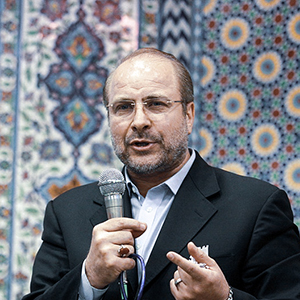
Mohammad Bagher Ghalibaf
- Current posts:
- Speaker of Parliament
- Member of Supreme National Security Council
- Past positions: Mayor of Tehran; National Police Chief
- Military rank: Major-general IRGC
- Political leaning: Neo-Principlists/securocrats
- Age: 58
- Notes: Two failed attempts for presidency (2005, 2013); faces multiple corruption accusations rooted in his mayoralty; notorious for crackdown as police chief on 1999 student protests
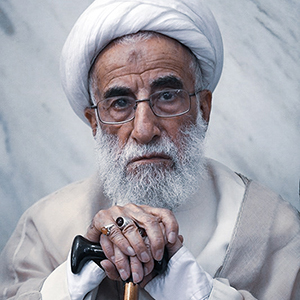
Ahmad Jannati
- Current Posts:
- Secretary of Guardian Council
- Chairman, Assembly of Experts
- Member of Expediency Council, Tehran Friday prayer leader
- Past positions: Tehran Friday prayer leader
- Political leaning: The Paydari – Principlists, close to securocrats
- Clerical rank: Ayatollah, Mujtahid (qualified to issue religious fatwas)
- Age: 93
- Notes: Notorious for pre-election purge of Reformists in 2020 parliamentary election; openly sided with Mahmoud Ahmadinejad in the 2009 disputed presidential election
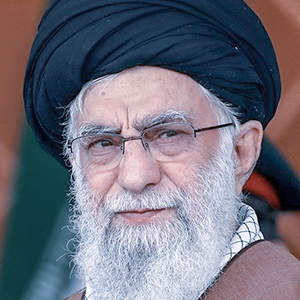
Ali Khamenei
- Current posts:
- Supreme Leader (appointed Iran’s second supreme leader by Assembly of Experts in 1989)
- Commander-in-chief of Islamic Republic Armed Forces
- Appoints figures in many non-elected institutions
- Past positions: President (1981-1989); Chairman of Assembly of Experts; member of parliament
- Clerical rank: Ayatollah, Mujtahid (qualified to issue religious fatwas)
- Political leaning: Not openly specified, but viewed as close to the Principlists and securocrats
- Age: 81
- Note: Final arbiter of Iran’s strategic domestic and foreign policy decisions

Mohammad Khatami
- Current posts: None
- Past positions: President (1997-2005); culture minister; director and founder of Baran Institute (NGO focused on domestic political activism)
- Clerical rank: Hojjat-ul-Islam
- Political leaning: Reformists
- Age: 76
- Note: Supports social, political, and human rights reforms; developed “Dialogue Among Civilisations” initiative; demonstrated influence through pre-election endorsement messages widely embraced by Iranian public

Ali Larijani
- Current posts:
- Member of Expediency Council
- Adviser to the supreme leader
- Past positions: Speaker of parliament (longest-serving); chief nuclear negotiator (2005-2007); member of the Supreme National Security Council; culture minister
- Military rank: Brigadier-general IRGC
- Political leaning: Traditional conservatives
- Age: 63
- Notes: Political career seen gradual shift from Principlists toward moderate centrist position adopted by President Rouhani; most powerful of several brothers in the influential Larijani family

Sadegh Amoli Larijani
- Current Posts:
- Chairman, Expediency Council
- Member of Assembly of Experts
- Past positions: Judiciary chief; member of Guardian Council
- Political leaning: Principlists
- Clerical rank: Ayatollah
- Age: 59
- Notes: One of several influential Larijani brothers; notorious for iron-fist clampdown on dissidents; departure from judiciary was marred by informal corruption allegations

Mohammad Taghi Mesbah-Yazdi
- Current Posts:
- Member of Assembly of Experts
- Past positions: Chairman of Ahl Al-Bayt World Assembly; member of Supreme Council of Cultural Revolution
- Political leaning: The Paydari – Principlists
- Clerical rank: Ayatollah, Mujtahid (Qualified to issue religious fatwas)
- Age: 85
- Notes: Seen as spiritual leader of the Paydari; sharp critic of Rouhani government; favours resilient economy model

Esmail Qaani
- Current posts:
- IRGC Quds Force Commander
- Past positions: Acting Quds Force commander, Iran-Iraq war veteran
- Political leaning: Securocrats
- Military rank: Brigadier-general
- Age: 62
- Notes: Has been a leading ground commander of Iranian forces involved in the Syria conflict; acted as Qassem Soleimani’s close adviser; has frequently warned against a continuation of US presence in the Middle East
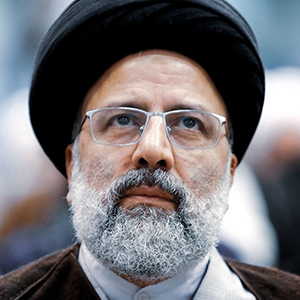
Ebrahim Raisi
- Current posts:
- Judiciary Chief (Appointed by supreme leader)
- Member of Supreme National Security Council
- Member of Assembly of Experts
- Past positions: Deputy head of Judiciary; Chairman of General Inspection Office
- Clerical rank: Hojjat-ul-Islam
- Political leaning: The Paydari – Principlists
- Age: 59
- Notes: Lost in 2017 presidential election; member of a powerful panel of judges that allegedly issued mass execution verdicts against thousands of Iranian political prisoners in the 1980s; head of major anti-corruption drive by the judiciary; proponent of resilient economy model
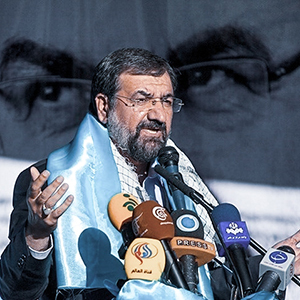
Mohsen Rezaee
- Current Posts:
- Secretary of Expediency Council
- Past positions: IRGC commander
- Political leaning: Principlists
- Military rank: Major-general
- Age: 65
- Notes: Three failed attempts for presidency; faces criticism over massive Iranian casualties caused by his perceived mishandling of multiple operations as IRGC commander during Iraq-Iran war; frequently promotes resilient economy model; vigorously opposes Rouhani’s policies
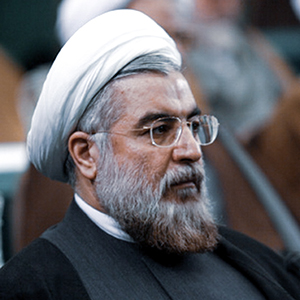
Hassan Rouhani
- Current posts:
- President (appointed through popular vote)
- Chairman of Supreme National Security Council
- Member of Assembly of Experts
- Member of Expediency Council
- Past positions: Chief nuclear negotiator (2003-2005); Secretary of the Supreme National Security Council; deputy parliament speaker
- Clerical rank: Hojjat-ul-Islam
- Political leaning: Moderate centrists
- Age: 71
- Note: Rouhani’s government negotiated 2015 nuclear deal; continues to advance pro-engagement policies; favours global modern industrialist approach to the economy; criticised by opponents for perceived concessions to West

Hossein Salami
- Current posts:
- IRGC Commander
- Past positions: Acting IRGC commander; Iran-Iraq war veteran
- Political leaning: Securocrats
- Military rank: Major-general
- Age: 60
- Notes: Known for his fierce anti-US, anti-Israeli rhetoric; has been an unyielding critic of Rouhani government; oversees IRGC missile launches and testing; announced Iran’s successful 2020 military satellite launch
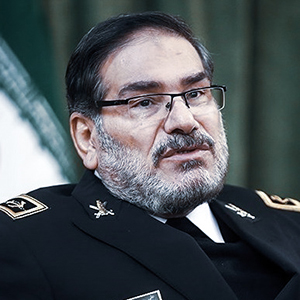
Ali Shamkhani
- Current posts:
- Secretary of Supreme National Security Council
- Member of Expediency Council
- Past positions: Defence Minister; Navy commander (both IRGC and regular military)
- Military rank: Rear-Admiral (IRGC Navy)
- Political leaning: Moderate centrist
- Age: 64
- Notes: Formerly a staunch supporter of nuclear deal but has gradually distanced from JCPOA; opposed house arrests imposed on Green Movement opposition leaders
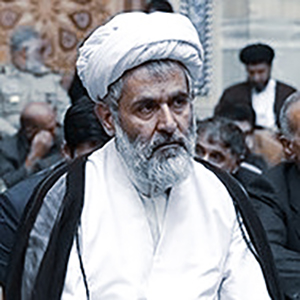
Hossein Taeb
- Current Posts:
- Head of IRGC Intelligence Organisation
- Past positions: Commander of Basij Organisation (IRGC militia branch)
- Political leaning: Securocrats
- Clerical rank: Hojjat-ul-Islam
- Age: 57
- Notes: Among most influential in supreme leader’s inner circle; makes rare public appearances; faces allegations of major crackdown against 2009 post-election detainees; leads IRGC’s counter-espionage efforts that have stepped up since 2015 nuclear deal

Ali Akbar Velayati
- Current Posts:
- International Affairs Adviser to Supreme Leader
- Past positions: Longest-serving foreign minister (1981-1997)
- Political leaning: Traditional conservatives/moderate centrists
- Age: 74
- Notes: Failed attempt for presidency in 2013; formerly strong advocate of JCPOA but has distanced himself from agreement; focused on Iran’s policy towards the Middle East

Mohammad Javad Zarif
- Current Posts:
- Foreign Minister
- Past positions: Iran’s ambassador to the United Nations (under Khatami administration)
- Political leaning: Modernisers (associated with Reformists)
- Age: 60
- Notes: Credited as architect of the JCPOA with the US under the Obama administration; known for diplomatic efforts with the George W Bush administration over Afghanistan and Iraq; favours global modern industrialist approach to the economy; attempted resignation in February 2019 rejected by Rouhani, his return to office welcomed by Qassem Soleimani and allegedly encouraged by the supreme leader
About the author
Ellie Geranmayeh is deputy director of the Middle East and North Africa programme at ECFR, where she focuses on European policy on Iran. She specialises in European foreign policy in relation to Iran, particularly on the nuclear and regional dossiers and sanctions policy. Prior to this, she was based at Herbert Smith Freehills LLP after graduating in law from the University of Cambridge.
Acknowledgements
This paper was enriched by discussions with Iranian and European policymakers and experts in addition to peer reviewers and the author’s researcher in Iran. The author would like to acknowledge colleagues Julien Barnes-Dacey, Jeremy Shapiro, and Adam Harrison for their thoughtful contributions and editorial support on this paper – and Edin Dedovic for developing the infographics.
[1] ECFR discussions with European and Iranian diplomats September, October and December 2019.
[2] ECFR interview with a senior figure within the Reformists camp, January 2020.
[3] ECFR interview with a senior political analyst on Iran, March 2020.
[4] ECFR interviews with political analysts in Iran, January-March 2020.
[5] ECFR interview with Adnan Tabatabai, CEO, Centre for Applied Research in Partnership with the Orient, February 2020.
[6] ECFR interview with an expert working closely on the IRGC, March 2020.
[7] ECFR interview with an expert working closely on the IRGC, March 2020.
[8] ECFR interview with a senior Iranian academic, April 2020.
[9] ECFR interview with senior political analysts engaged on domestic politics in Iran, February 2020.
[10] ECFR interview with senior political analysts engaged on domestic politics in Iran, February 2020.
[11] Comments by a senior figure engaged in Iranian domestic politics, February 2020.
[12] Comments by a senior Iranian official, February 2020.
[13] ECFR interview with a senior figure within modernisers’ camp, January 2020.
[14] Comments by one senior figure deeply engaged in Iranian politics, February 2020.
[15] ECFR interview with a senior economist working on Iran, March 2020.
[16] ECFR interview with a senior economist working on Iran, February 2020.
[17] ECFR interview with Iranian political analyst with close links to the Principlists, February 2020.
[18] ECFR interview with a senior economist who focuses on Iran, April 2020.
[19] ECFR interview with a senior economist who focuses on Iran, May 2020.
[20] ECFR interview with a senior economist who focuses on Iran, April 2020.
[21] Comments by a senior figure within the modernisers’ camp, February 2020.
[22] Comment by an Iranian security expert, February 2020.
[23] Comment by a senior Iranian expert closely linked to the Reformists, February 2020.
[24] Comments by a senior figure deeply engaged in Iranian politics, February 2020.
[25] Comments by Saeed Ghassemi, a military strategist and former IRGC officer, 17 February 2020.
[26] ECFR interview with an expert connected to the Principlists, February 2020.
[27] ECFR interviews with Iranian security experts, June 2019-March 2020.
[28] ECFR interview with an Iranian political analyst, March 2020.
[29] Comments by a senior Emirati official, February 2020.
[30] Comments by a senior Saudi interlocutor, January 2020.
[31] Interview with European and US officials, 2019-2020.
[32] ECFR interview with a senior Iranian political analyst, March 2020.
The European Council on Foreign Relations does not take collective positions. ECFR publications only represent the views of their individual authors.

